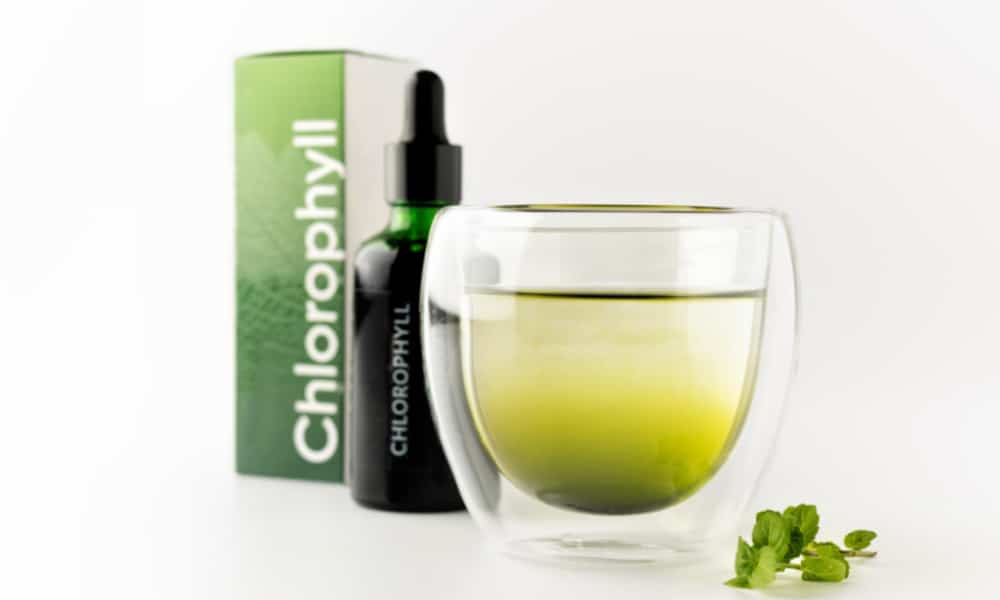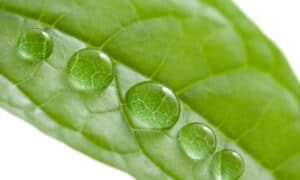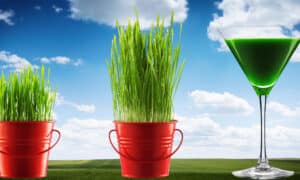Can You Take Liquid Chlorophyll While Breastfeeding
It is not uncommon for trends related to health and wellness to emerge on social media platforms like TikTok. Liquid chlorophyll is one such trend that has gained popularity on TikTok and other social media platforms.
On TikTok, you may find videos of people making and drinking chlorophyll water and videos showcasing the supposed benefits of chlorophyll water. Some people may use TikTok to share their experiences with chlorophyll water and promote it as a healthy beverage.
It is essential to remember that social media trends should not be taken as medical advice. It is always a good idea to speak with a healthcare professional before making any changes to your diet or lifestyle. It is also essential to be aware that not all information shared on social media platforms is reliable or backed by scientific evidence.
In this article, we will discuss in detail what chlorophyll is. Can you take chlorophyll while breastfeeding? And we will discuss the benefits and risks of chlorophyll as a food supplement.
This article will discuss all you need to know if you are planning to start using chlorophyll food supplements.
What is chlorophyll?
Chlorophyll is a pigment found in plants, algae, and some bacteria. It is responsible for absorbing light energy and converting it into chemical energy through photosynthesis. Chlorophyll is essential for plant growth and survival, enabling plants to produce food and oxygen. There are several different types of chlorophyll, including chlorophyll a, chlorophyll b, and chlorophyll c. Each class has a slightly different chemical structure and absorbs light at different wavelengths, but all chlorophyll pigments play a crucial role in photosynthesis. In plants, chlorophyll is found in the chloroplasts of cells, surrounded by other pigments, such as carotenoids, that help absorb light and protect the chlorophyll from damage.
Chlorophyll Water
Chlorophyll water is a beverage made by infusing water with chlorophyll, a pigment found in plants responsible for absorbing sunlight and converting it into energy through photosynthesis. Chlorophyll is often referred to as the “green blood” of plants because it is found in their leaves and stems in high concentrations.
Chlorophyll water is often marketed as a natural detox drink that can help flush toxins from the body and improve digestion. Some claim chlorophyll water can boost energy levels, help with weight loss, improve skin health, and reduce inflammation.
There is limited scientific evidence to support these claims, and more research is needed to determine the potential health benefits of chlorophyll water. However, many people enjoy drinking chlorophyll water as a refreshing and hydrating beverage. It may be a good source of hydration and electrolytes, especially if made with pure, high-quality chlorophyll and clean water.
Liquid chlorophyll
Liquid chlorophyll is a supplement made from chlorophyll extracted from plants, usually alfalfa or wheatgrass. It is typically sold in a liquid form that can be mixed with water or added to smoothies or other beverages.
Liquid chlorophyll is often marketed as a health supplement due to its potential health benefits, including supporting detoxification, improving digestion, reducing inflammation, and boosting energy levels. However, the evidence for these benefits is mainly anecdotal and more research is needed to confirm the effectiveness of chlorophyll supplements.
It is important to note that while chlorophyll is a natural substance, it is not a regulated dietary supplement in the United States, so the purity and quality of different chlorophyll supplements can vary.
Chlorophyll Water Recipe
To make chlorophyll water at home, you will need the following ingredients:
- Chlorophyll supplement (liquid or capsules)
- Water
- Optional: Lemon or lime juice, sweetener (such as honey or maple syrup), herbs or spices (such as mint or ginger) for flavor
Here is a simple recipe for making chlorophyll water:
- Begin by filling a glass or bottle with water. If you prefer flavored water, you can add a squeeze of lemon or lime juice and a sweetener or herbs to the water.
- Next, add the chlorophyll supplement to the water. You can add a few drops to the water using liquid chlorophyll. If you are using chlorophyll capsules, you can open the capsules and add the contents to the water.
- Stir the water to dissolve the chlorophyll and combine the ingredients.
- Enjoy your chlorophyll water immediately, or refrigerate it for later use. It is best to consume chlorophyll water within a few hours of preparation to ensure that it is at its freshest.
Remember that the dosage of chlorophyll supplement recommended on the package should be followed. Overconsumption of chlorophyll may lead to unwanted side effects such as nausea and diarrhea.
Signs of Pregnancy Presumptive, Probable, Positive Full Fact Sheet
If I’m going to try it, what is the best way to consume chlorophyll water
Chlorophyll water is typically consumed as a beverage and can be found in liquid or powder form. It can be mixed with water or added to other drinks, such as smoothies or juices. Some people also add chlorophyll water to their diet as a base for salad dressings or marinades.
It is important to note that there is limited scientific evidence to support the potential health benefits of chlorophyll water, and more research is needed to understand its effects fully. As with any supplement, it is essential to talk to a healthcare provider before using chlorophyll water and to follow the recommended dosage on the product label.
Can You Take Chlorophyll While Breastfeeding
It is generally considered safe to consume chlorophyll while breastfeeding. Chlorophyll is found in many foods, such as leafy green vegetables, and is also available in supplement form. While there is limited research on the safety of chlorophyll supplements, specifically in breastfeeding women, chlorophyll is a natural compound in many plant-based foods. It is generally considered safe when consumed in average dietary amounts.
Can You Shake Breast Milk? Myths About Breastmilk Storage & Handling
There is limited research on the safety of chlorophyll supplements during breastfeeding. While chlorophyll is a natural plant substance, it is not a regulated dietary supplement in the United States. Therefore, the purity and quality of different chlorophyll supplements can vary.
It is always a good idea to speak with a healthcare provider before starting any new supplement regimen, especially during breastfeeding. Your healthcare provider can help you evaluate chlorophyll supplements’ potential risks and benefits and determine whether they are appropriate for you.
In general, it is crucial to be cautious when taking any supplement while breastfeeding, as the substances in the supplement may be passed to the baby through breast milk. This can be especially concerning for supplements that have not been well-studied or are not regulated by the Food and Drug Administration (FDA).
In addition, it is essential to be mindful of your diet while breastfeeding, as the nutrients you consume can affect the quality of your breast milk and your baby’s health. It is generally recommended to focus on a healthy, well-balanced diet that includes a variety of fruits, vegetables, whole grains, and protein sources rather than relying on supplements to meet your nutritional needs.
What Are the Benefits of Chlorophyll
Chlorophyll has been claimed to have several potential health benefits, although more research is needed to understand its effects fully. Some of the possible benefits of chlorophyll include the following:
- Antioxidant properties: Chlorophyll is thought to have antioxidant properties, which may help protect cells from damage caused by free radicals. Free radicals are unstable molecules that can cause damage to cells and are thought to contribute to the development of chronic diseases.
- Detoxification: Some people claim chlorophyll can help detoxify the body by removing toxins and heavy metals from the bloodstream. However, there is limited scientific evidence to support this claim.
- Weight loss: Chlorophyll is a pigment that gives plants their green color and plays a crucial role in photosynthesis, the process by which plants use energy from sunlight to produce food. Some people believe that chlorophyll may have various health benefits, including aiding in weight loss. However, there is limited scientific evidence to support these claims. Some proponents of chlorophyll for weight loss suggest that it can reduce appetite, increase metabolism, and improve digestion, which could lead to weight loss. However, there is little scientific research to back up these claims.
- Improving wound healing: Some research suggests that chlorophyll may help promote wound healing by increasing collagen production and other substances necessary for tissue repair.
- Reducing inflammation: Some studies have found that chlorophyll may have anti-inflammatory effects, which may help reduce inflammation in the body. Chronic inflammation has been linked to several health problems, including heart disease and cancer.
- Digestion: Chlorophyll may help to improve digestion by promoting the growth of beneficial bacteria in the gut and reducing odor-causing bacteria.
- Blood health: Chlorophyll may help to support healthy blood by increasing the production of red blood cells and reducing the risk of anemia.
- Energy: Some people report that chlorophyll supplements can help to increase energy levels.
- Cancer prevention: While more research is needed, some studies have suggested that chlorophyll may have anti-carcinogenic properties and may help to prevent the development of certain types of cancer.
- Blood builder: chlorophyll can act as a blood builder. Chlorophyll is structurally similar to hemoglobin, a protein in red blood cells responsible for carrying oxygen to the body’s cells. Some people believe that chlorophyll can help to increase the production of red blood cells, which can help to improve oxygenation and circulation in the body.
- Heart health: Some studies have shown that chlorophyll may help lower cholesterol levels and reduce the risk of heart disease.
- Skin Healing: There are several potential benefits of chlorophyll for skin health. Research suggests that chlorophyll has antioxidant and anti-inflammatory properties, which help protect the skin from damage caused by free radicals and reduce redness and swelling. Chlorophyll may also help improve skin healing by promoting the growth of new cells and tissue growth.
Risks Involved in Taking Chlorophyll
It is important to note that more research is needed to fully understand the potential health benefits of chlorophyll and determine the appropriate dosage and duration of use.
There are some potential risks associated with taking chlorophyll supplements. These include:
- Interactions with medications: Chlorophyll may interact with certain medications, such as blood thinners and medicines that are metabolized by the liver.
- Allergic reactions: Some people may be allergic to chlorophyll, plants, or algae containing chlorophyll. Symptoms of an allergic reaction may include rash, hives, itching, and difficulty breathing.
- Stomach upset: Chlorophyll supplements may cause stomach upset, such as nausea, vomiting, and diarrhea.
- Dark stools: Chlorophyll supplements may cause stools to turn green or dark green, which may be a temporary side effect.
- Reduced absorption of certain nutrients: Chlorophyll may interfere with the absorption of certain nutrients, such as iron, from the gastrointestinal tract.
- Interference with lab test results: Chlorophyll supplements may interfere with specific lab results, such as thyroid function and liver function.
- Risk of contamination: Some chlorophyll supplements may be contaminated with heavy metals, pesticides, or other toxins.
- Risk of contamination with toxic algae: Chlorophyll supplements may be made from algae, and some algae can produce toxins that may be harmful if ingested.
- Risk of contamination with microcystins: Some algae used to make chlorophyll supplements may contain toxins produced by certain types of cyanobacteria (also known as blue-green algae).
- Risk of contamination with BMAA: Some algae used to make chlorophyll supplements may contain BMAA (beta-N-methylamino-L-alanine). This neurotoxin has been linked to the development of neurodegenerative diseases such as Alzheimer’s disease and Parkinson’s disease.
- Risk of contamination with microplastics: Some algae used to make chlorophyll supplements may contain tiny plastic particles that can enter the environment through the breakdown of more oversized plastic products. Microplastics have been linked to several health problems, including hormonal imbalances and reproductive issues.
It is essential to choose high-quality chlorophyll supplements free from contaminants and follow the recommended dosage on the product label.
How to take chlorophyll supplements
Chlorophyll supplements are available in various forms, including capsules, tablets, and liquid. The recommended dosage can vary depending on the product and the reason for taking it. It is essential to follow the product label instructions and consult with a healthcare provider before taking any supplements.
To take a chlorophyll supplement in capsule or tablet form, swallow the recommended number of pills with a glass of water. If you are taking a liquid chlorophyll supplement, follow the instructions on the label for the recommended dosage. Taking chlorophyll supplements with meals is generally recommended to help improve absorption.
It is essential to remember that supplements are not regulated by the Food and Drug Administration (FDA) in the same way that medications are. This means that the safety and effectiveness of supplements can vary. It is always a good idea to speak with a healthcare provider before starting any new supplement, especially if you have a health condition or are taking medications.
Natural vs Chlorophyll Supplements
There are some potential differences between natural sources of chlorophyll and chlorophyll supplements:
- Nutrient content: Natural sources of chlorophyll, such as leafy green vegetables, often contain other nutrients, such as vitamins, minerals, and fiber, that may not be present in chlorophyll supplements.
- Dosage: It can be challenging to consume enough chlorophyll from natural sources to achieve the recommended supplement dosage.
- Quality: Natural sources of chlorophyll may be higher than some chlorophyll supplements, as they may be less likely to be contaminated with heavy metals, pesticides, or other toxins. However, it is vital to choose high-quality supplements that are free from contaminants.
- Convenience: Chlorophyll supplements may be more convenient to use than natural sources, as they are available in capsule or liquid form and can be taken at any time.
Postpartum Hemorrhage Nursing Diagnosis-Risks-Care Plan-Management







One Reply to “Can You Take Liquid Chlorophyll While Breastfeeding”